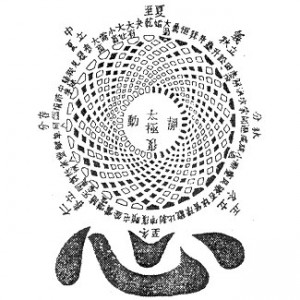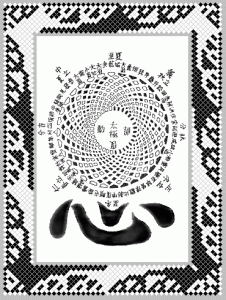Taiji – Supreme Ultimate & Phyllotaxis – leaves arrangement
In the early 2000s, my “Symmetry” workshop fellow in Moscow, a well-known sinologist Vladimir Yeremeyev presented me a small drawing of something like a flower. Unfortunately, Vladimir died in July 2011. This publication is a tribute to a remarkable scientist.
He said that the drawing refers the Middle Ages, not much else.
I scanned this little picture. The quality left much to be desired, but it was good for my set goal.
Picture 1. The enigmatic figure.
Then I was interested in the regularity of arrangement of the white and black “seeds” in the flower (stem). The serious occupation of leaves arrangement instilled in me the skills of transition from the Cartesian coordinate system to polar and vice versa. So sunflower seeds are placed in a polar system, but cone scales are arranged in a cylindrical coordinate system, which gives the Cartesian system with a sweep of the cylinder.
Transformation of the Chinese “flower” has led to the drawing.
Picture 2. I saw a black tree
Picture 3. The same sweep from the other starting point draws a white tree.

Picture 4. The sweep of more than one turn.
Pay attention to the antisymmetry of the drawing. Change of the color of image components on the opposite color does not change the nature of the drawing. Negative in some sense is an equivalent to a positive.
In symmetry theory the group of anti-symmetry is a group consisting of transformations that can change not only the geometric position of the object, but also its two-valued characteristic. Such a two-valued characteristic may be, for example, the charge (plus or minus), the color (black or white), the sign of a real function, the spin direction (up and down). Groups are also called antisymmetry groups of magnetic symmetry, as well as groups of black and white symmetry.
In the layered arrangement of black and white “seeds” dichotomy can clearly be seen, and as a consequence of the dichotomy – fractality appears. There is an image of a tree with branches.
It is easy to see similarities of our picture with the graphic image of the Great Limit, which can be found at Yeremeyev’s works and other sources.
Picture 5. Great Limit.
Taiji 太極 (literally “great pole”) Great limit (“Supreme Ultimate”) (Taiji Chines. trad. 太极, simplified. 太极 tàijí) – in the Chinese philosophy life limiting condition, the highest beginning, the beginning of all beginnings, before highlighting the forces of yin – feminine and yang – the male. The opposite category – Nolimit (Y Ji 无极 wújí).
是故,易有太極,是生兩儀,兩儀生四象,四象生八卦,八卦定吉凶,吉凶生大業。
Thus, I Ching (“Book of Changes”) contains the Taiji (“Supreme Ultimate”). It creates a duality of images. Duality produces images of four characters. Four characters give rise to the eight trigrams. The eight trigrams determine the good fortune and misfortune. Happiness and unhappiness give birth to the great work.
(Russian translation of Vladimir Yeremeyev)
I have attached а Cartesian frame to the polar drawing in order to make the East picture more attractive to the Western audience.
Picture 6. Polar drawing with Cartesian frame.
Forgive me, Chinese sages.
Dmitry Weise. July 2012
P.S. Who has information about this picture and the inscription on it, write me a comment, please.





